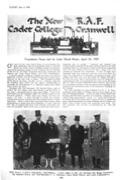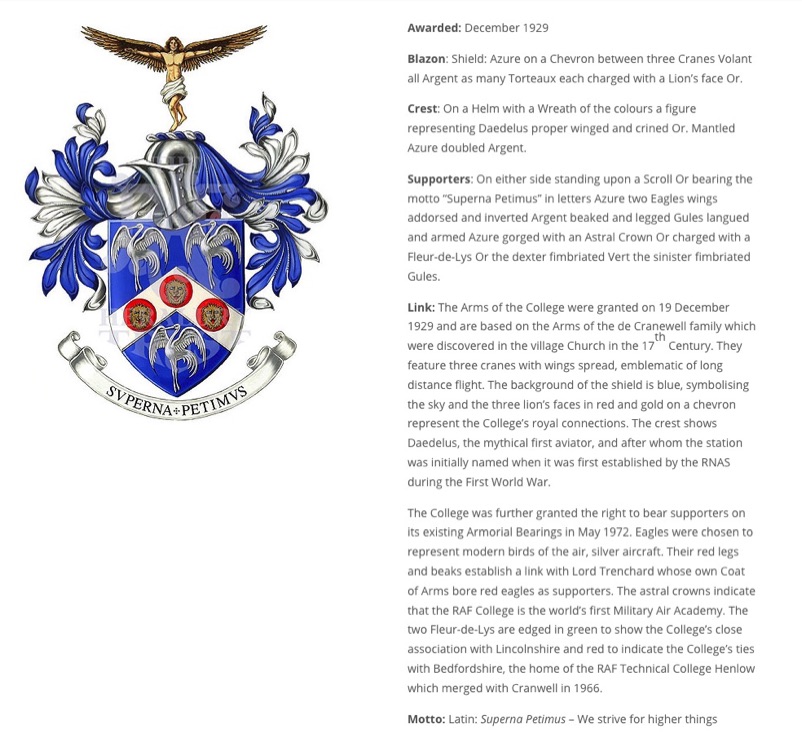

YEAR BOOK 1929
1928

Lady Maud and her silver trowel of deception
RAF College Cranwell was founded in 1920 but initially was housed in wartime barrack blocks. Sir Michael Hoare, who was the Secretary of State for Air (1922-1929) lobbied for a permanent home, to encourage permanence, ethos and belonging to the officer cadets of the new Service and in 1929 took a huge risk by commissioning a design, based on the Royal Hospital Chelsea, with no authority to build as there was an election due therefore he had to act fast.
tTo ensure that the building of College Hall was funded post-election, Lord Trenchard and Sir Samuel Hoare arranged for an official laying of the foundation stone before the dissolution of Parliament. Lady Maud used a silver trowel which is on display in the College.
It is believed that this ceremony was a ploy to persuade the government to fund the building. The Labour government who came into power post the general election accepted the proposed plan and proceeded to fully fund the building works.



Citation
The London Gazette of 18th October, 1929, gives the following details in announcing the award to Group Captain (then Flight Cadet) McKechnie of the Empire Gallantry Medal, which was exchanged for the George Cross by the terms of the institution of that award in September 1940: On 20th June, 1929, an aeroplane piloted by Flight Cadet C. J. Giles crashed on landing at Cranwell aerodrome and burst into flames. The pilot was stunned, but managed to release his safety belt and fall out of the machine in a dazed condition. Flight Cadet McKechnie, who had landed in another aeroplane about the same time some two hundred yards away, left his machine and ran at full speed towards the scene of the accident. The petrol had spread over an area about ten yards in diameter, in full blaze, with Giles lying in it semi-conscious. McKechnie, without hesitation, ran into the flames and pulled out Giles, who was badly burned. McKechnie, who was himself scorched and superficially burned, then proceeded to extinguish Giles's burning clothing. There is no doubt that without McKechnie's assistance Giles would have been burned to death, as he was quite incapable of moving himself. His machine was entirely destroyed, and the ground for some distance around was burned up by the spread of the ignited petrol.
1929
The College hitherto known as "The Royal Air Force (Cadet) College" adopted the permanent title "The Royal Air Force College"
Sir George Gillet
The point which my hon. and gallant Friend the Member for Central Hull (Lieut.-Commander Kenworthy) raised with regard to the ex-penses at Cranwell came under my notice when I was looking at the net charges in connection with the maintenance of buildings, plant, etc., and other miscellaneous expenditure, and it is rather extraordinary to find that at Cranwell, where the number of cadets is 98, this figure is put down at £7,750 for the year. At Andover, where accommodation is provided for 30 students, the figure is only £800. I can only conclude that the exceedingly heavy figure has something to do with the point which my hon. and gallant Friend has just raised in regard to the cost of the buildings. It may be due to debt charges or otherwise. This item, being so heavy, naturally has an effect upon the average cost per student, which at Cranwell is £561 a year. That figure is nearly £100 higher than it is at the military colleges, for at Woolwich it is £473 and at Sandhurst £483. I think these are comparable figures, because in both cases the sum includes allowances. Perhaps the Minister could explain why the figure at Cranwell is so exceedingly heavy.
HANSARD March 1929
Debate in Full
HISTORY
&
HERITAGE
